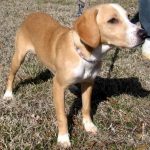
Goldendoodles come in many show-stopping and beautiful coat colors. But if you are looking for the not-so-common varieties, your best option will be the red Goldendoodles. Thinking of bringing a Goldendoodle home soon? Read on to learn more about their coat texture and how to differentiate them from other shades.
Red Goldendoodle’s History
Many red Goldendoodles are developed by breeding the Irish setter, Golden Retriever, and the Poodle. All these breeds may have a red coat but the Irish setter has the richest red color. In most cases, breeders achieve it by pairing a male red Standard Poodle and a female red Golden Irish.
In case you haven’t come across the Golden Irish, it is the result of pairing a purebred Irish setter and a Golden retriever. This crossbreed is a medium shedder but when paired with the Poodle, there is a big possibility the offspring will be low shedding.
Appearance of Red Goldendoodle
Red Goldendoodles come in different shades and coat textures. Like the Poodles, their coat can be straight, shaggy, or curly. Some may have a lighter shade of red while others may have a darker coat color.
It is important to know the differences between every coat texture because it also determines a dog’s shedding potential. Here are the three main types of Goldendoodle coat textures:
Straight – A straight-coated Goldendoodle is also called the flat-coated Goldendoodle. It does not possess the curl gene. The advantage of having a straight-coated Goldendoodle is that you will not have a hard time grooming your pet. The only drawback is it is not ideal for households with hypersensitivity to pet hair.
Wavy – this kind of coat texture occurs when a dog with a curl gene mated with one dog with a non-curl gene. Also called “fleece,” a shaggy Goldendoodle is preferred by many Doodle dog aficionados. This is because it is hypoallergenic but it does not require so much grooming compared to a curly Goldendoodle.
If your pup has waves on its muzzle, you will likely have a pooch with a wavy or shaggy coat. For shaggy Goldendoodles, you will need more time brushing and bathing because their coat is more prone to developing mats and you will need to shampoo the dog for longer for the product to soak in.
Curly – these Goldendoodles usually have more of the Poodle gene in their lineage. For instance, the F2B Goldendoodle consists of 62.5% Poodle and 37.5% Golden Retriever. That is why they are often mistaken for being Poodles. Like shaggy Goldendoodles, it is also possible for them to have a curly coat texture if they have waves on the muzzle. There is a common belief that curly Goldendoodles do not shed.
This is just a misconception because the hair only gets stuck to the other curls. Among all the Poodle textures, the curly coat is the most preferred of all of them. These curls are tight and a bit wool-like just like the Poodle’s coat. The only disadvantage to having a curly Goldendoodle is that it will be difficult to groom.
Red Goldendoodle’s Breedig
In developing the red Goldendoodle, breeders usually avoid developing pups with liver noses. This is usually because there is a little chance they will come up with a true red dog. The only way to steer clear of this is to only breed dark red dogs with a black nose.
Red dogs are often mistaken with apricot. However, there are a few fine points that set them apart. For example, a true red Goldendoodle will display a deep red coloring while an apricot one will exhibit a peach-like coating. They are also usually lighter in color.
A true red Goldendoodle will have a coat color closer to the one of the Irish setter. This breed originated in the 1700s. Although it is known for its signature solid red color, this deep red color was only developed during the late 1800s. Not all Irish Setters are red, with some of them either having a chestnut or a mahogany color.
But did you know that back then, the red Irish Setters did not have coat colors as solid as we see them today? During the early times, the red Irish setters had black or white markings all over the body. This can be because they have the Red and White Setter in their lineage. Fast forward to the present time, we can see red Irish setters sporting a rich and deep color.
When you have a Poodle puppy, you will not easily determine its coat texture just by looking at the body. As pups, it can be hard to distinguish because most Doodle dogs may look like they all just inherited the Poodle coat. You will even have a bigger chance of knowing this by observing the facial fur and the pup’s muzzle.
Red Goldendoodle’s Grooming
Regardless of their color, the grooming requirements will heavily depend on the Goldendoodle’s coat texture. Obviously, those with wavy or straight hair are easier to groom, while those with curly coat will definitely take longer and will be more expensive to maintain. It’s just a matter of your tolerance to pet hair, because these dogs have different shedding levels.
If you have a curly Goldendoodle, it helps to have a large slicker brush handy. It is efficient in getting rid of mats and tangles. Compared to other dog brushes, a slicker brush is easier to use because it usually comes with a large wooden handle. If your Goldendoodle’s curly coat is thick, it will help to use a brush with wire bristles.
In addition to a slicker brush, it is also helpful to invest in a greyhound style comb. Often made of steel, this comb will be effective in getting rid of deep tangles that you cannot easily remove using a slicker brush. It is a bit more expensive compared to other dog combs but it is usually made of durable and high-quality material that is built to last.
You can find color treatment shampoos specially formulated for red coats. These products work by depositing the same color spectrum as the Goldendoodle’s natural color while cleaning it. But you can use any standard shampoos created for dogs, if you cannot find a color treatment shampoo.
If your dog has sensitive skin, you may ask for recommendations from your vet regarding medicated shampoos for dogs. Sensitive skin is characterized by blemishes and sores. Take note that it is not always easy to spot because not all dogs will have a balding patch. Sometimes, you will have to look deeper to see the flaky skin and the bright red rashes.
Red Goldendoodles normally require a full bath every three months, but this will still depend on your pet’s activities or lifestyle. If he is always indoors, a bath once every three months will be enough to maintain his coat. But if he always gets dirty, you may give him a bath every two weeks.
Bathing the dog in a raised tub makes the job easier. But if you don’t have one at home, you may do it in a deep laundry room or a walk-in shower. Water should not be too cold to avoid your dog from getting chills. Check if the water is lukewarm or if your dog can tolerate the hotness before giving him a bath.
In addition to bathing and brushing the Red Goldendoodle, it also requires clipping or trimming. You need to bring your pooch to a professional groomer every eight weeks so he can have his hair trimmed. You can also do it yourself but make sure you are equipped with the right tools to do so.
There are also books and YouTube tutorial videos teaching you step-by-step how to properly clip Doodle dogs. Simply follow the instructions because you can save a lot of money by grooming your pooch at home instead of bringing him to a professional groomer from time to time. The prices of grooming sessions may vary, depending on the region where you live. It usually costs $50 or more per session complete with a full bath.
Price of Red Goldendoodle
A red Goldendoodle is not considered to be rare but they are usually more expensive than common colors like white and black. With a red Goldendoodle, you can expect to pay anywhere from $2000 to $3000 per pup.
Before paying the hefty price, do your research about the breeder first. How were the parents bred? Do they have red, white, or silver in their lineage? It is important to know this because some breeders result in having cream-colored dogs when pairing red and apricot ones.
In addition to the color, a pup’s health and gender may also have an impact on the Goldendoodle’s price. But pay attention to the health records to confirm if the dog is a result of pairing true red colored dogs.
Health of Red Goldendoodle
As crossbreeds, Goldendoodles are also considered as heterotic or possessing a hybrid vigor. In heterosis, the traits of the parents are enhanced as a result of combining the genetic contributions of the Golden Retriever and the standard Poodle.
The biological qualities of Goldendoodles are improved because of genetic diversity. In layman’s term, this happens when two unrelated breeds collide resulting in a positive hybrid. This explains why mixed breeds are healthier than purebred dogs.
In spite of this, mixed breeds may be prone to health issues common in both the Golden Retrievers and Poodles. Keep an eye for the symptoms of the following conditions:
- Hip Dysplasia – this hereditary condition is a result of having an abnormal function in the hip socket. Instead of sliding into place, the joints grind against each other when the dog moves. This causes pain, lameness, and even arthritis.
- Eye Diseases – there are eye afflictions occurring in canines but the most common type among Poodles are cataracts or the cloudiness in the lens that cause blurry eyes. If not addressed immediately, this can result in blindness especially at old age.
- Heart Disease – this is more common in small breeds than large breeds. Poodles are prone to Mitral Valve Disease (MVD), which thickens the heart valves and causes some of the blood to flow backward. MVD is characterized by fainting, shortness of breath, and high rates of breathing.
- Degenerative Myelopathy – it is a progressive disease that usually starts at old age. In some dogs, symptoms of degenerative myelopathy begin at 8 years of age but in some, it does not occur until 14 years.
- Progressive retinal atrophy – this group of genetic diseases causes progressive vision loss that can turn to blindness. It is comparable to retinitis pigmentosa in humans, which happens when there is a breakdown of cells in the retina.
Important Reminders before Getting a Red Goldendoodle
Prior to making a final decision, get all the necessary litter facts from your prospect breeder. This includes the type of the dog, whether it is an F1, an F1B, or multi-generation Goldendoodle. These Doodles have different percentages of the Poodle breed in their lineage.
Get the profile of both parents to confirm if the pup really is the product of a true red dog. As pups, the Red Goldendoodle may appear to be brown or a lighter shade of red but they will eventually display their true colors upon reaching adulthood.
Conclusion
Red Goldendoodles are stunning but remember that they are no different from other Doodle dogs in terms of personality. They are family-friendly, gentle, and active. There are many red dogs waiting in shelters for their new pet parents to shower them with love and affection. As always, we remind you to be careful with meeting with online breeders. Do your research before buying or adopting your red Goldendoodle.
More Goldendoodles color you might wish to know:
Red Mini Goldendoodles: https://ebknows.com/red-mini-goldendoodle/
Chocolate Goldendoodles: https://ebknows.com/chocolate-goldendoodle/






















